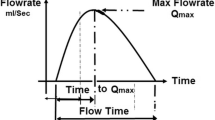Abstract
Uroflowmetry, the simple, non-invasive measurement of urine flow over time during micturition, has a long and interesting history, clear definitions, a clear purpose in screening for voiding difficulty and, most importantly, technical accuracy. Data interpretation is currently limiting its clinical utility, despite appropriate analysis being available in long-standing existing research. The main clinically important numerical parameters are the maximum and average urine flow rates and the voided volume. Urine flow rates are strongly dependent on voided volume. Reference to established (Liverpool) nomograms will most accurately correct for this dependency. Nomograms will also optimise the validation of uroflowmetry data and the accurate assessment of its normality, compared with fixed urine flow rates and “cutoffs” for voided volume. Abnormally slow urine flow (under the 10th centile Liverpool Nomograms) is the most clinically significant abnormality. Repeat uroflowmetry, concomitant post-void residual measurement and voiding cystometry studies are appropriate options for evaluating any abnormal uroflowmetry.


Similar content being viewed by others
References
Rehfisch E (1897) Ueber den mechanismus des harnblasenverschlusses under der harnentkerung. Virchow Arch Path Anat 150:1111–1151
Ryall RL, Marshall VR (1983) Measurement of urinary flow rate. Urology 22:556–564
Gronwell H (1925) Blastomningens mechanism. Sven Lakartidn 22:577
Drake WM Jr (1948) The uroflowmeter: an aid to the study of the urinary tract. J Urol 59:650–658
Von Garrelts B (1956) Analysis of micturition. A new method of recording the voiding of the bladder. Acta Chir Scand 112:326–340
Rowan D, McKenzie AL, McNee SG, Glen ES (1977) A technical and clinical evaluation of the Disa uroflowmeter. Brit J Urol 49:285–293
Peter WP, Drake WM Jr (1958) Uroflowmetric observations in gynaecologic patients. JAMA 166:721–724
Farrar DJ, Osborne JL (1984) Voiding dysfunction in women. In: Mundy AR, Stephensen TP, Wein AJ (eds) Urodynamics: principles, practice and application, chapter 23. Churchill Livingstone, Edinburgh, pp 242–248
Bergman A, Bhatia NN (1985) Uroflowmetry for predicting postoperative voiding difficulties in women with stress urinary incontinence. Brit J Obstet Gynaecol 92:835–838
Axelrod SL, Blaivas JG (1987) Bladder neck obstruction in women. J Urol 137:497–499
Torrens MJ (1987) Urodynamics. In: Torrens MJ (ed) The physiology of the lower urinary tract, chapter 9. Springer, Berlin, pp 277–307
Bates P, Glen ES, Griffiths D, for the International Continence Society et al (1977) Second report on the standardization of terminology of lower urinary tract function, procedures related to the evaluation of micturition—flow rate, pressure measurement, symbols. Scand J Urol Nephrol 11:197–199
Haylen BT, Lee J (2008) The accuracy of measurement of the postvoid residual in women. Int Urogynecol J DOI 10.1007/s00192-008-0568-0
Wyndaele J-JJM (2006) Uroflowmetry. In: Cardozo LD, Staskin D (eds) Textbook of female urology and urogynecology. Informa Healthcare, Oxford, pp 216–221
Nitti VW, Fischer MC (2008) Urodynamics. In: Bent AE, Cundiff GW, Swift SE (eds) Urogynecology and pelvic floor dysfunction. Lippincott, Williams and Wilkins, Philadelphia, p 79
Moore KH, Richmond DH, Sutherst JR et al (1991) Crouching over a toilet seat: prevalence amongst British gynaecological outpatients and its effect on micturition. Brit J Urol 98:569–572
Massey JA, Abrams PH (1988) Obstructed voiding in the female. Brit J Urol 61:36–39
Fantl JA, Smith PJ, Schneider V et al (1982) Fluid weight uroflowmetry in women. Am J Obstet Gynecol 145:1017–1024
Costantini E, Mearini E, Pajoncini C et al (2003) Uroflowmetry in female voiding disturbances. Neurourol Urodyn 22:569–573
Fantl JA (1984) Clinical uroflowmetry. In: Ostergard DR (ed) Gynecologic urology and urodynamics: theory and practice, chapter 11. 2nd edn. Williams and Wilkins, Baltimore, pp 125–132
Haylen BT, Ashby D, Sutherst JR et al (1989) Maximum and average urine flow rates in normal male and female populations—the Liverpool Nomograms. Brit J Urol 64:30–38
Haylen BT, Law MG, Frazer MI, Schulz S (1999) Urine flow rates and residual urine volumes in urogynaecology patients. Int Urogynecol J 6:378–383
Haylen BT, Parys BT, Anyaegbunam WI, Ashby D (1990) Urine flow rates in male and female urodynamic patients compared with the Liverpool Nomograms. Brit J Urol. 65:483–487
Ryall RL, Marshall VR (1982a) Normal peak urinary flow rate obtained from small voided volumes can provide a reliable assessment of bladder function. J Urol 127:484–487
Groutz A, Blaivas JG, Chaiken DC (2000) Bladder outflow obstruction in women: definition and characteristics. Neurourol Urodyn 19:213–220
Dawson T, Lawton V, Adams E, Richmond D (2007) Factors predictive of post-TVT voiding dysfunction. Int Urogynecol J 18:1297–1302
Bottacini MR, Gleason DJ (1980) Urodynamic norms in women: normals vs stress incontinents. J Urol 124:659–661
Haylen BT, Krishnan S, Schulz S et al (2007) Has the true prevalence of voiding difficulty in urogynecology patients been underestimated? Int Urogynecol J 18:53–56
Haylen BT (2007) The empty bladder. Int Urogynecol J 18:237–239
Ryall RL, Marshall VR (1982) The effect of a urinary catheter on the measurement of maximum urine flow rate. J Urol 128:429–432
Conflicts of interest
None.
Author information
Authors and Affiliations
Corresponding author
Rights and permissions
About this article
Cite this article
Haylen, B.T., Yang, V. & Logan, V. Uroflowmetry: its current clinical utility for women. Int Urogynecol J 19, 899–903 (2008). https://doi.org/10.1007/s00192-008-0597-8
Received:
Accepted:
Published:
Issue Date:
DOI: https://doi.org/10.1007/s00192-008-0597-8




